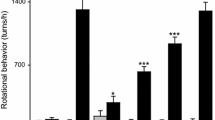Degeneration of dopaminergic (DAergic) neurons of the nigrostriatal system is the key stage in the pathogenesis of Parkinson’s disease. The fi rst symptoms of this disease are observed after degeneration of 70-80% neurons, which occurs over 20–30 years. The clinical stage of Parkinson’s disease begins after this period. Late diagnostics of Parkinson’s disease contributes to low effi ciency of therapi for this disorder. Detailed study of the pathogenesis and development of preclinical diagnostic methods for Parkinson’s disease are the urgent problems. This work was designed to develop a new experimental model of the preclinical and clinical stages of the disease. Experimental modeling was performed on C57Bl/6 mice using 1-methyl-4-phenyl-1,2,3,6-tetrahydropyridine (MPTP). This agent is converted into the MPP+−neurotoxin in brain DAergic neurons. We showed that MPTP in a dose of 4 mg/kg has no effect on the nigrostriatal DAergic system. MPTP in a dose of 8–16 mg/kg produced the toxic effect only on DAergic axons, which simulates the preclinical stage of Parkinson’s disease. MPTP in a dose of 20–40 mg/kg had the toxic effect on neuronal axons and bodies, which simulates the clinical stage of Parkinson’s disease. The data suggest that progressive degeneration of DAergic neurons is accompanied by activation of compensatory mechanisms for functional defi ciency of these cells.
Similar content being viewed by others
References
G. N. Kryzhanovsky, I. N. Karaban’, S. V. Magaeva, et al., Parkinson’s Disease (Etiology, Pathogenesis, Clinical Course, Therapy, and Prevention) [in Russian], Moscow (2002).
Y. Agid, Lancet, 337, 1321–1324 (1991).
M. Beltramo, A. Calas, E. Chernigovskaya, et al., Neuroscience, 63, No. 2, 603–610 (1994).
E. Bezard, S. Dovero, C. Prunier, et al., J. Neurosci., 21, No. 17, 6853–6851 (2001).
G. N. Kryzhanovsky, V. G. Kucheryanu, N. A. Krupina, et al., Pathophysiology, 4, 59–67 (1997).
M. Nirenberg, R. Vaughan, G. Uhl, et al., J. Neurosci., 16, No. 2, 436–447 (1996).
G. Rozas, I. Liste, M. Guerra, and J. Labandeira-Garcia, Neurosci. Lett., 245, No. 3, 151–154 (1998).
J. L. Tillerson and G. W. Miller, J. Neurosci. Methods, 123, No. 2, 189–200 (2003).
K. Tipton and T. P. Singer, J. Neurochem., 61, No. 4, 1191–1206 (1993).
M. Ugrumov, Handbook of Neurochemistry and Molecular Neurobiology, Ed. E. S. Vizi, Heidelberg (2008), pp. 21–53.
Author information
Authors and Affiliations
Corresponding author
Additional information
Translated from Byulleten’ Eksperimental’noi Biologii i Meditsiny, Vol. 150, No. 11, pp. 494–497, November, 2010
Rights and permissions
About this article
Cite this article
Khaindrava, V.G., Kozina, E.A., Kudrin, V.S. et al. Experimental modeling of preclinical and clinical stages of Parkinson’s disease. Bull Exp Biol Med 150, 566–569 (2011). https://doi.org/10.1007/s10517-011-1191-5
Received:
Published:
Issue Date:
DOI: https://doi.org/10.1007/s10517-011-1191-5



